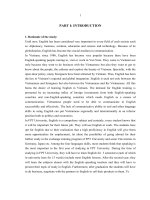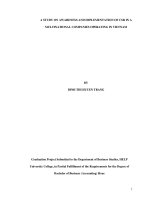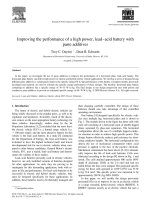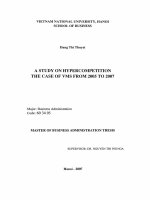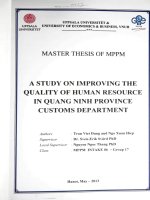A study on improving the performance of control charts under non normal distributions
Bạn đang xem bản rút gọn của tài liệu. Xem và tải ngay bản đầy đủ của tài liệu tại đây (2.97 MB, 198 trang )
A STUDY ON IMPROVING
THE PERFORMANCE OF CONTROL CHARTS
UNDER NON-NORMAL DISTRIBUTIONS
SUN TINGTING
NATIONAL UNIVERSITY OF SINGAPORE
2004
A STUDY ON IMPROVING
THE PERFORMANCE OF CONTROL CHARTS
UNDER NON-NORMAL DISTRIBUTIONS
SUN TINGTING
(B. Eng. & B. Sci., USTC)
A THESIS SUBMITTED
FOR THE DEGREE OF MASTER OF ENGINEERING
DEPARTMENT OF INDUSTRIAL AND SYSTEMS
ENGINEERING
NATIONAL UNIVERSITY OF SINGAPORE
2004
Acknowledgement
I
ACKNOWLEDGEMENT
I would like to express full of my sincere gratitude to my main supervisor, Professor Xie
Min, who is one of the most diligent, devoted and kind people I have ever met. I am very
grateful to him not only for his invaluable guidance, patience and support throughout my
study and research in NUS and the whole revision after I started working, but also for his
great care and help during my staying in Singapore. I also would like to thank my second
supervisor, Doctor Vellaisamy Kuralmani for his useful advice and consistent support for
my research.
Besides, I am indebted to all the faculty members of the ISE department for their kind
assistance in my study and research. I am also indebted to Institute of High Performance
Computing, which has sponsored me to accomplish my research work.
I extend all of my gratitude to my friends Philippe, Chen Zhong, Tang Yong, Robin,
Vivek, Igna, Jiying, Henri, Chaolan, Josephine, Reuben, Teena, Tao Zhen, Shujie, just
name a few, who have made my two years’ stay in NUS an enjoyable memory. I treasure
the precious friendships they have offered me, which will not fade away as time goes by.
Finally, my wholehearted thankfulness goes to my dear parents for their continuous
encouragement and support as well as their never-fading love for me.
TABLE OF CONTENTS
II
TABLE OF CONTENTS
ACKNOWLEDGEMENT I
TABLE OF CONTENTS II
SUMMARY VI
NOMENCLATURE VIII
LIST OF FIGURES IX
LIST OF TABLES XII
Chapter 1. Introduction
1.1. Research background and Motivations 1
1.2. Objective of the Thesis 4
1.3. Organization of the Thesis 5
Chapter 2. Literature Review
2.1. Introduction 6
2.2. Literature Review on Non-normality Issue on Control Charts 7
2.2.1. Attribute Charts 7
2.2.2. Variable Charts 12
2.2.3. Individual and Multivariate Charts 15
TABLE OF CONTENTS
III
2.3. Literature Review on Normalizing Transformations 18
2.3.1. Generic Distributions 18
2.3.2. Specific Distributions and Statistic Families 20
2.3.2. Summary 33
Chapter 3. Investigation of the Probability Limits in Traditional Shewhart R- Charts
3.1. Introduction 35
3.2. Positive LCL of R-chart for Improvement Detection 38
3.2.1. The need of a positive LCL for R-chart 38
3.2.2. The distribution of the range 40
3.2.3. The probability limits for R 42
3.2.4. False alarm probability and run length properties 46
3.3. Implementation Example and Discussions 52
3.4. Conclusions 57
Chapter 4. Study on Normalization Transformation in Traditional Shewhart Charts
4.1. Introduction 58
4.2. Adaptation of Transformation in Non-normal Process 60
4.2.1. The need for a transformation 60
4.2.2. Performance discussion on some distributions 64
4.2.3. Implementations 73
4.3. Implementation Examples and Discussions 74
4.3.1. Transformation on t-distribution: Application on individual chart 74
TABLE OF CONTENTS
IV
4.3.2. Transformation on U-statistic: Application on S-chart 83
4.4. Conclusions 91
Chapter 5. Study on Normalization Transformation in Multivariate Charts
5.1. Introduction 92
5.2. Multivariate Process Model and Control Limits Setting 94
5.2.1. Multivariate Process Model and control limits setting 94
5.2.2. Non-normality Drawbacks on Hotelling
2
T
chart 97
5.3. Best Normalizing Transformation 103
5.3.1.
2
χ
-distribution 103
5.3.2. F-distribution 105
5.4. Implementation and Example 113
5.4.1. Transformation selection and Implementing Procedures 113
5.4.2. An Implementation Example 116
5.5. Performance Comparison 119
5.5.1. An investigation of the Average Run Length and discussions 119
5.5.2. Simulation studies on Comparison to Box-Cox transformation 129
5.6. Conclusions 132
Chapter 6 Conclusions
6.1. Concluding Remarks 134
6.2. Limitations and Recommendations for Future Research 135
TABLE OF CONTENTS
V
References 137
Appendix I 153
Appendix II 155
Appendix III 158
Summary
VI
SUMMARY
The control chart is a graphical tool that aids in the discovery of assignable causes of
variability in these quality measurements. Shewhart type control charts are the most
commonly used method to test whether or not a process is in-control. The basic idea is that
given a quality measurement, which independently identically follows normal distribution,
k-sigma limits would be use to detect an out-of-control signal. Usually k is set as 3 to
achieve very desirable ARL properties. However, the assumption of having iid normal
population is invalid in many cases, especially encountered frequently in real-application.
Thus, the traditional 3-sigma limits for the Shewhart charts may not be appropriate in
certain situations.
Exact probability limits are good alternatives to traditional 3-sigma control limits. The
deduction of exact probability control limits of R- and S- charts has shown better
properties in sense of signals at both sides of the limits in this thesis. This results in
revised values for control chart construction constants D
3
and D
4
. The new values of the
constants provide a positive lower control limit for the process when the sampling
subgroup size is lee than 6. Thus, the decrease of the process deviation can be detected at
earlier stage.
Summary
VII
The theoretical achievements in normalizing transformations provide another way to deal
with the non-normality problem in constructing control charts with broader area of
applications. In this paper, after being transformed to a normal distribution, the quality
characteristic of traditional control charts can be simply monitored by a traditional
Shewhart type individual chart. Although the transformed chart has its intrinsic defects,
such as the extreme difficulty in interpretation and uncertainty in approximation, a
valuable trade-off between the accuracy of normalizing and the simplicity of application is
obtained. We illustrate that normalizing transformation could improve the performance of
control limits in the sense that it achieves more desirable ARL performance, such as faster
signals to process deterioration and symmetric responding. Moreover, sometimes, the
control charts based on normalized data performs better than the exact probability charts
as well. In this thesis we recommend some good forms of transformations to use and
propose some simplifies forms for particular cases.
This thesis consists of 6 chapters. Chapter 1 is the brief introduction of this study. Chapter
2 is literature review of the related topics, non-normality problems in traditional control
charting scheme and normalizing transformations. Chapter 3 focuses on the application of
modifying the traditional control limits in R- and S-charts, which is probability limits
related. Chapter 4 discusses more general method by applying various normalizing
transformations on traditional Shewhart type control charts. Chapter 5 discusses the
normalizing transformations, in particular, on multivariate control charts. Simplified forms
have been raised. At the end of the thesis, the conclusion is given in Chapter 6.
Nomenclature
VIII
NOMENCLATURE
AD Anderson-Darling test
ARL average run length
CL center line
CuSum cumulative sum
EWMA exponentially weighted moving average
iid independently identically distributed
LCL lower control limit
LPL lower probability limit
MBB moving blocks bootstrap
MEWMA multivariate exponentially weighted moving average control chart
pdf probability density function
RL run length
SD standard deviation
SPC statistical process control
UCL upper control limit
UPL upper probability limit
List of Figures
IX
LIST of FIGURES
Figure 3.1 Probability density function of the range
Figure 3.2 ARL-curve of traditional R-chart
Figure 3.3
Full OC-curves for R-charts. (Adapted from Duncan(1979), pp445)
Figure 3.4
ARL-curve of modified R-chart
Figure 3.5
Full OC-curves for modified R-charts
Figure 3.6
X
and R charts for the data in Table 3.4.
Figure 3.7
X
and R charts for the example by using probability limits
Figure 4.1 PDF of a right-skewed distribution
Figure 4.2 PDF of a standard normal distribution
Figure 4.3 ARL-curves of S-chart with different size of subgroup
Figure 4.4 ARL-curves of the probability limit S- charts with different size of subgroup
Figure 4.5 ARL-curves of the control chart on normalized S with different size of
subgroup
Figure 4.6 ARL-curve of traditional limits for Exponential-distribution
Figure 4.7
ARL-curves of probability limits and traditional limits on normalized data
for Exponential-distribution
Figure 4.8 ARL distributions of control limits on t-distribution and normalized t for
n=2
List of Figures
X
Figure 4.9 ARL distribution of control limits on t-distribution and normalized t for
n=10
Figure 4.10 ARL distribution of control limits on t-distribution and normalized t for
n=20
Figure 4.11 Histogram of the Data in Table 4.4
Figure 4.12 Normal probability plot of the data in Table 4.4
Figure 4.13 Exponential Probability Plot of the Data in Table 4.4
Figure 4.14 Normal Probability Plot of Data in Table 4.4
Figure 4.15 Traditional Individual Chart for Transformed Table 4.4 Data
Figure 4.16 Ideal Out-of-control ARL for Traditional Shewhart Type Control Chart
Figure 4.17 Traditional Individual Chart for t-distributed Data in Table 4.4
Figure 4.18 Exact Probability Limits for Data in Table 4.4
Figure 4.19 Out-of-control Average Run Length of Exact Probability Limits
Figure 4.20 Histogram of Transformed Data in Table 4.7
Figure 4.21 Traditional Individual Chart for Transformed Data in Table 4.7
Figure 4.22 Out-of-control ARL for Individual Chart on Transformed Table 4.7 Data
Figure 4.23 Traditional S chart for Data in Table 4.6
Figure 4.24 Out-of-control ARL for control chart in Figure 4.21 under shift from 0 to
3
σ
Figure 4.25 Exact Probability Limits for Data in Table 4.6
Figure 4.26 Out-of-control ARL for S-chart under Exact Probability Limits on Data in
Table 4.4 with shift from -0.5
σ
to 2
σ
List of Figures
XI
Figure 5.1
The Hotelling
2
T
control chart for data in Table5.1 (Phase II)
Figure 5.2
ARL performance of Hotelling
2
T
chart
Figure 5.3
Hotelling
2
T
chart for variance reduced process data
Figure 5.4
Histogram of
2
T
statistics data in the example
Figure 5.5 Normal probability plot of transformed data in Table 5.5
Figure 5.6 Individual chart for transformed data
Figure 5.7 ARL distribution of probability limits and limits on normalized
F-distribution (v=100)
Figure 5.8 ARL distribution of probability limits and limits on normalized
F-distribution (v=20)
Figure 5.9 ARL distribution of probability limits and limits on normalized
F-distribution (v=400)
Figure 5.10
ARL-curves of Hotelling-
2
T
chart and normalized chart (p=2, m=15)
Figure 5.11
ARL-curves of Hotelling-
2
T
chart and normalized chart (p=2, n=3)
Figure 5.12
ARL-curves of Hotelling-
2
T
chart and normalized chart (m=15, n=3)
Figure 5.13
ARL-curves of Hotelling-
2
T
chart and normalized chart (p=8, m=35)
Figure 5.14
ARL-curves of Hotelling-
2
T
chart and normalized chart (m=50, n=10)
Figure 5.15
ARL-curves of Hotelling-
2
T
chart and normalized chart (p=8, n=10)
List of Tables
XII
LIST OF TABLES
Table 2.1 Summary table of recommend normalizing transformations
Table 3.1
Some probability LCL/UCL for R-chart (
1
=
σ
) for different false alarm
probability
Table 3.2
Some probability
*
3
D
/
*
4
D for R-chart ( 1
=
σ
) for different false alarm
probability
Table 3.3 Tail probability of traditional R-chart
Table 3.4 A set of simulated data with subgroup size of five
Table 4.1 Tail probability of traditional S-chart
Table 4.2 Tail probability of traditional R-chart
Table 4.3 Tail probability of traditional limits on Exponential distribution with some
λ
Table 4.4 Data from a Production Line
Table 4.5 Kittlitz Transformation of Table 4.4 Data
Table 4.6 Data of Sample Standard Deviation from N(0,1)
Table 4.7 Fujioka & Maesono Transformed Data in Table 4.6
Table 4.8 Data of Sample Standard Deviation from N(0,1)
Table 4.9 Fujioka & Maesono Transformed Data in Table 4.8
Table 5.1
2
T
-statistics for the shifted process 1
List of Tables
XIII
Table 5.2
2
T
-statistics for the shifted process 2
Table 5.3
2
T
values of the data in the example
Table 5.4 Transformed data in Table 5.3
Table 5.5 Tail probabilities for F-distribution for some of the parameters
Table 5.6 Transformed data in Table 5.5
Table 5.7
2
T
-statistics from shifted process
Table 5.8 Transformed data in Table 5.6
1
Chapter 1
Introduction
1.1. Research Background and Motivation
Quality control schemes are widely used to improve the quality of a manufacturing
process. It is often the case that some aspects of the quality of the output of a process can
be described in terms of one or more parameters of the distribution of a quality
measurement. The control chart is a graphical tool that aids in the discovery of assignable
causes of variability in these quality measurements. It is used to monitor a process for the
purpose of detecting special causes of process variation that may result in lower-quality
process output.
Shewhart type control charts are the most commonly used method to test whether or not a
process is in-control. The basic idea is that given a quality measurement, a Shewhart chart
with 3-sigma control limits can be constructed as
σ
µ
kUCL
+
=
µ
=
CL
σ
µ
kLCL
−
=
(1.1)
Chapter 1 Introduction
2
where
µ
and
σ
denote the mean and the standard deviation of the quality measurement,
respectively, k=3, usually. Define
i
E to be the event that i-th sample measurement
i
X is
either above UCL or below LCL. Then the events
{
}
i
E are independent and for all i ≥ 1,
() ( )
(
)
(
)
0027.0331 =
−
Φ
+
Φ
−
=
<
∪>= LCLXUCLXPEP
iii
(1.2)
where Φ is the distribution function of a
(
)
1,0N random variable. If we define U to be the
number of samples until the first
i
E occurs, then U is known as the run length of the chart
and has a geometric distribution with parameter
(
)
0027.0
=
=
i
EPp . It follows that the
average run length (ARL) defined as the mean (E) of U and the standard deviation (SD) of
U are given by
()
4.370
1
==
p
UE
and
()
9.369
1
=
−
=
p
p
USD
(1.3)
All the above calculations are often based on two assumptions: that sample observations
are statistically independent, and that the monitoring statistic follows a normal distribution.
These are the two assumptions for constructing both Shewhart type variable charts and
attribute charts. However these assumptions are invalid in many cases and subsequently
become debatable. Especially, non-normality is encountered frequently in real-application.
Winterbottom (1993) mentioned this problem as very often the exact distribution is
positively skewed, and this means that control limits are set significantly lower than they
should be in order to come reasonably close to giving false alarm probabilities that
Chapter 1 Introduction
3
correspond to those on
X
charts. Moreover, even if the quality characteristic monitored
follows normal distribution some variables we plot on the control charts, i.e. the range
R
and the sample deviation
S, differ from normal distribution, so that the traditional 3-sigma
limits of
R-chart and S-chart do not perform as well as desired.
The validity of normal distribution has been questioned in some control charting
applications. Some authors had studied the problem. Since the statistic used for
monitoring with attribute data usually have underlying distributions which are skewed to
the right, the traditional 3-sigma limits for the Shewhart charts may not be appropriate as
pointed out by Woodall (1997) and Xie et al. (2002). For geometric distribution, Xie et al.
(1997) suggested that the traditional 3-sigma limits should not be used in this case because
the geometric distribution is always skewed and normal approximation is not valid. Xie et
al. (1992) calculated the exact probability limits that have been adopted in most of the
publications. Probability-based methods for determining control limits have been
discussed by Ryan and Schwertman (1997). They provided tables producing optimal
control limits for
u and c charts. Shore (2000) developed a methodology to construct
control charts for attributes data. One of the features is to use far-tail quantile values to
determine probability limits, control limits, or other performance measures. These quantile
values are derived from a fitted distribution that preserves all first three moments of the
plotted statistic.
However, few literatures have addressed the issues on solving non-normality problem in
traditional Shewhart control charting scheme. Therefore, it would be very useful and
Chapter 1 Introduction
4
contributive if any approach on that could be raised. Moreover, the approach should be
simple and friendly-to-use without losing much of the accuracy and precision.
1.2. Objective of the Thesis
We have raised two approaches in this research to solve the non-normality problem we
introduced in the section 1.1. The first approach is based on the exact distribution for the
sample ranges and sample standard deviations. Control limits, especially the lower control
limits are derived based on a fixed false alarm probability. The new control limits will
always be positive and hence enable the chart users to detect process shift in terms of
reduction in the process variability. The second approach is to make use of
transformations. This solution succeeds in making a balanced control limits so that the
ARL is large when the process behaves normally and smaller when the process deviates
(Yang and Xie (2000)). However, this issue has not gained much attention in control
charting scheme though many statisticians examined the transformation forms for various
kinds of distributions to normalize them. To summarize those existing transforming
formulas could contribute to the work dealing with non-normal data in process monitoring.
Extensive simulation has been done to prove that using normalizing transformation results
in satisfactory control chart performance in the sense of some desirable properties with
ARL achieved under some circumstances. Moreover, simplified transformations are also
proposed for more convenient use of certain distributions. A valuable trade-off between
the accuracy of normalizing transformation and simplicity of applications has been
obtained, which would benefit the industrial applications.
Chapter 1 Introduction
5
1.3. Organization of the Thesis
The remainder of this thesis is organized as follows:
Chapter 2 reviews the relative literature mainly focused on non-normality problems in
traditional Shewhart type control charts and multivariate charts, and summarizes the
papers looking into normalizing transformations.
Chapter 3 studies the application of modifying the traditional control limits in
R- and S-
charts. The procedures are presented and the tables for modification are provided as well.
Chapter 4 discusses more general method by applying various normalizing
transformations on traditional Shewhart type control charts, including transformation
selection and performance improvement comparison.
Chapter 5 contains the mathematical background and simplified approach of using
transformations in multivariate control charts; the procedures to apply the chart are
presented followed by an example.
Chapter 6 concludes the study. Further study and limitation are also discussed.
6
Chapter 2
Literature Review
2.1. Introduction
Non-normality problem has a vital influence on the performance of control charting
schemes. Therefore, volumes of research have been carried out on this issue. The research
ideas on applying control charts for non-normal populations can be divided into three
categories. The first category has concentrated on the robustness of various control charts’
performance to departures from the normality assumption so that the traditional charts can
be employed within a reasonable scope. Borror et al (1999) even studied the issue of
robustness on exponential weighted moving average (EWMA) control charts. However,
this limits our intention in implementing the control charting scheme in more cases.
Stoumbos and Sullivan (2002), The second category of research effort has attempted to
develop control charts that either may be generally applied to non-normal populations
after certain adjustment, like Xie et al (2000) to solve the so-called ARL-biased
phenomenon or control charts that explicitly specify an underlying non-normal population;
that is exact probability limits. The third category of endeavors to address the non-
normality of process distribution has focused on transforming to normality the given data,
Chapter 2 Literature Review
7
so that traditional Shewhart control charting schemes could be employed with desirable
average run length.
In the following section, we will review the literatures on non-normality problem in
traditional Shewhart type charts, including the emergence of the problem, its effect, the
solutions proposed as well as the related research trend. In section 2.2.1, section 2.2.2 and
section 2.2.3, we will review the research work, in particular on attribute charts, variable
charts and individual and multivariate charts. We will generalize some of the
achievements that have been made by mathematicians and statisticians in the area of
normalizing transformations in section 2.3. Section 2.3.1 and section 2.3.2 will discuss the
transformation forms for generic distributions, some specific distributions and statistic
families, respectively.
2.2. Review on Non-normality Issue on Control Charts
2.2.1. Attribute Charts
Control charting methods based on attribute data were first proposed by Shewhart in 1926.
The p and np charts are widely used, primarily to monitor the fraction of non-conforming
products. The c chart and u chart, on the other hand, can be used to monitor the number of
non-conformities. The p and np chart control limits and performance measures are
typically based on the binomial distribution whereas those of the c and u charts are based
on the Poisson distribution. Woodall (1997) pointed out that, since the statistics used for
Chapter 2 Literature Review
8
monitoring with attribute data usually have underlying distributions which are skewed to
the right, the traditional k-sigma limits for the Shewhart charts may be inappropriate.
Among others Ryan and Schwertman (1997) proposed some probability-based methods
for determining control limits in order to improve the control charts’ performance, They
pointed out that control chart properties are determined by the reciprocals of the tail areas,
but most approximations, including normal approximation, perform the poorest in the tails
of the distributions. Normal approximations can also be poor when the binomial and
Poisson parameters are small, as will occur frequently in applications. They, therefore,
provided tables that can be used to produce optimal control limits for u and c charts. They
used regression to extrapolate the optimal limits between the tabular values. The
regression equations are then suitably adapted for use with p and np charts, for which a
complete set of tables of optimal control limits would not be practical to construct.
Ryan (1998) indicates the contradiction in employing approximations. He showed that
most approximations, including the normal approximations to the binomial and Poisson
distributions, generally perform the poorest in the tails of a distribution. But control chart
properties are determined by the reciprocals of the actual tail areas. These problems have
resulted in new methods being proposed for determining the control limits for attribute
charts.
Actually, Winterbottom (1997) talked about this problem as very often the exact
distribution is positively skew, and this means that control limits are set significantly
Chapter 2 Literature Review
9
lower than they should be in order to come reasonably close to giving false alarm
probabilities that correspond to those on
X
charts. He also mentioned that for attribute
charts one can always calculate exact control limits in the sense that the false alarm
probabilities are as close as possible, but do not exceed, designate levels. The inequality is
due to the discrete nature of attribute data. Winterbottom, thus, improved the probabilistic
accuracy of control limits for all of the previously mentioned attribute charts by
determining the adjustment which makes use of the Cornish-Fisher-expansions (Cornish
and Fisher (1937)). These adjustments given by Cornish and Fisher, or corrections, depend
in simple ways on sample sizes, process parameter values and the standard normal value
used as a multiplier of sigma in the unmodified formula.
H. Shore (2000) developed a new methodology to construct control charts for attributes
data. Let Y be a measured attribute with known mean
µ
, standard deviation
σ
and
skewness sk . The general expressions for the probability limits of a general control chart
for attribute is developed as
UPL=
()
2
1
7978.0
2
1
−−++
−
σσµ
CCAz
q
CL=
µ
LPL=
()
2
1
7978.0
2
1
+−−+
−
σσµ
CCAz
q
, (2.1)
where A and C are the solution to
22
3635.01 CA −=
and
3
6523.03940.2 CCsk −=
Chapter 2 Literature Review
10
For highly skewed distribution, modifications were made by Shore (2000). He also
developed simplified limits based on some approximation assumptions and extended them
into probability limits for the binomial, the Poisson, the geometric and the negative
binomial distributions.
For p-chart, more specifically, Simon (1995) suggested using probability limits such that it
would be equally likely for a false alarm to happen on either side of the control chart.
Ryan (1997) studied the arcsine transformation, as given by Freeman and Tukey (1996) to
construct a chart for monitoring p. Chen (1997) developed a variant of Ryan’s chart.
Another approach to the problem is to use a Q chart as developed by Quesenberry (1999).
The Q chart provides a better approximation to the nominal upper tail area than arsine
approach. Acosta-Mejia (1999) proposed an alternative to replace the lower control limit
by a simple runs rule.
For c-chart, the modified 3-sigma control limits has been proposed by Winterbottom
(1997) using Cornish and Fisher expansions for c chart. Q charts, proposed by
Quesenberry (1992) can also be employed as an alternative to replace a c chart or u chart,
and also as an alternative to standardized versions of these charts. Ryan (1995) indicated
that it seems preferable to seek closeness to the reciprocals of the nominal tail areas rather
than closeness to those tail areas. For u chart, Ryan also used a similar method.
As pointed out by Woodall (1997), more recently, it has been recommended that it is
useful to base control charts on the number of conforming items found between non-



